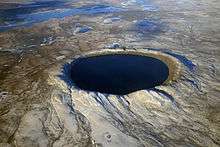Cretaceous–Paleogene boundary
The Cretaceous–Paleogene (K–Pg) boundary, formerly known as the Cretaceous–Tertiary (K-T) boundary,[lower-alpha 1] is a geological signature, usually a thin band of rock. K, the first letter of the German word Kreide (chalk), is the traditional abbreviation for the Cretaceous Period and Pg is the abbreviation for the Paleogene Period.
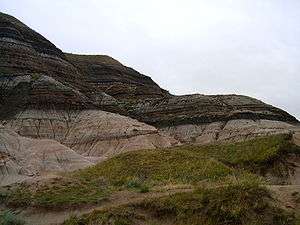
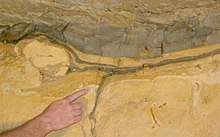
The K–Pg boundary marks the end of the Cretaceous Period, the last period of the Mesozoic Era, and marks the beginning of the Paleogene Period, the first period of the Cenozoic Era. Its age is usually estimated at around 66 Ma (million years ago),[2] with radiometric dating yielding a more precise age of 66.043 ± 0.011 Ma.[3]
The K–Pg boundary is associated with the Cretaceous–Paleogene extinction event, a mass extinction which destroyed a majority of the world's Mesozoic species, including all dinosaurs except for birds.[4]
Strong evidence exists that the extinction coincided with a large meteorite impact at the Chicxulub crater and the generally accepted scientific theory is that this impact triggered the extinction event.
Possible causes
Alvarez impact hypothesis
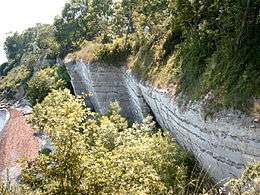
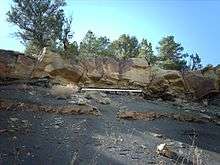
In 1980, a team of researchers consisting of Nobel Prize-winning physicist Luis Alvarez, his son, geologist Walter Alvarez, and chemists Frank Asaro and Helen Michel discovered that sedimentary layers found all over the world at the K–Pg boundary contain a concentration of iridium many times greater than normal (30 times the average crustal content in Italy and 160 times at Stevns on the Danish island of Zealand).[5] Iridium is extremely rare in the earth's crust because it is a siderophile element, and therefore most of it sank with iron into the earth's core during planetary differentiation. As iridium remains are abundant in most asteroids and comets, the Alvarez team suggested that an asteroid struck the earth at the time of the K–Pg boundary.[5] There were other earlier speculations on the possibility of an impact event, but no evidence had been uncovered at that time.[6]
The evidence for the Alvarez impact theory is supported by chondritic meteorites and asteroids which have an iridium concentration of ~455 parts per billion,[7] much higher than ~0.3 parts per billion typical of the Earth's crust.[5] Chromium isotopic anomalies found in Cretaceous–Paleogene boundary sediments are similar to those of an asteroid or a comet composed of carbonaceous chondrites. Shocked quartz granules and tektite glass spherules, indicative of an impact event, are also common in the K–Pg boundary, especially in deposits from around the Caribbean. All of these constituents are embedded in a layer of clay, which the Alvarez team interpreted as the debris spread all over the world by the impact.[5]
Using estimates of the total amount of iridium in the K–Pg layer, and assuming that the asteroid contained the normal percentage of iridium found in chondrites, the Alvarez team went on to calculate the size of the asteroid. The answer was about 10 km (6.2 mi) in diameter, about the size of Manhattan.[5] Such a large impact would have had approximately the energy of 100 trillion tons of TNT, or about 2 million times greater than the most powerful thermonuclear bomb ever tested.
One of the consequences of such an impact is a dust cloud which would block sunlight and inhibit photosynthesis for a few years. This would account for the extinction of plants and phytoplankton and of organisms dependent on them (including predatory animals as well as herbivores). However, small creatures whose food chains were based on detritus might have still had a reasonable chance of survival. Vast amounts of sulfuric acid aerosols were ejected into the stratosphere as a result of the impact, leading to a 10–20% reduction in sunlight reaching the Earth's surface. It would have taken at least ten years for those aerosols to dissipate.[8][9]
Global firestorms may have resulted as incendiary fragments from the blast fell back to Earth. Analyses of fluid inclusions in ancient amber suggest that the oxygen content of the atmosphere was very high (30–35%) during the late Cretaceous. This high O
2 level would have supported intense combustion. The level of atmospheric O
2 plummeted in the early Paleogene Period. If widespread fires occurred, they would have increased the CO
2 content of the atmosphere and caused a temporary greenhouse effect once the dust cloud settled, and this would have exterminated the most vulnerable survivors of the "long winter".[8]
The impact may also have produced acid rain, depending on what type of rock the asteroid struck. However, recent research suggests this effect was relatively minor. Chemical buffers would have limited the changes, and the survival of animals vulnerable to acid rain effects (such as frogs) indicates that this was not a major contributor to extinction. Impact theories can only explain very rapid extinctions, since the dust clouds and possible sulphuric aerosols would wash out of the atmosphere in a fairly short time—possibly under ten years.[10]
Chicxulub Crater
| Chicxulub impact structure | |
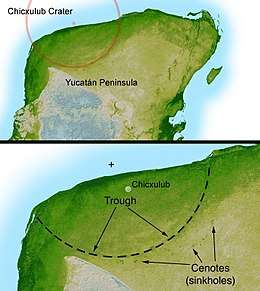 Imaging from NASA's Shuttle Radar Topography Mission STS-99 reveals part of the 180 km (110 mi) diameter ring of the crater. The numerous sinkholes clustered around the trough of the crater suggest a prehistoric oceanic basin in the depression left by the impact.[11] | |
| Impact crater/structure | |
|---|---|
| Confidence | Confirmed |
| Diameter | 150 km (93 mi) |
| Depth | 20 km (12 mi) |
| Impactor diameter | 10–15 kilometres (6.2–9.3 mi) |
| Age | 66.043 ± 0.011 Ma Cretaceous–Paleogene boundary[12] |
| Exposed | No |
| Drilled | Yes |
| Bolide type | Carbonaceous chondrite |
| Location | |
| Coordinates | 21°24′0″N 89°31′0″W |
| Country | |
| State | Yucatán |
 Chicxulub crater Location of Chicxulub crater | |
When it was originally proposed, one issue with the "Alvarez hypothesis" (as it came to be known) had been that no documented crater matched the event. This was not a lethal blow to the theory; while the crater resulting from the impact would have been larger than 250 km (160 mi) in diameter, Earth's geological processes hide or destroy craters over time.[13]
The Chicxulub crater ( /ˈtʃiːkʃʊluːb/; Mayan: [tʃʼikʃuluɓ]) is an impact crater buried underneath the Yucatán Peninsula in Mexico.[14] Its center is located near the town of Chicxulub, after which the crater is named.[15] It was formed by a large asteroid or comet about 10 to 15 kilometres (6.2 to 9.3 miles) in diameter,[16][17] the Chicxulub impactor, striking the Earth. The date of the impact coincides precisely with the Cretaceous–Paleogene boundary (K–Pg boundary), slightly less than 66 million years ago,[12] and a widely accepted theory is that worldwide climate disruption from the event was the cause of the Cretaceous–Paleogene extinction event, a mass extinction in which 75% of plant and animal species on Earth suddenly became extinct, including all non-avian dinosaurs.
The crater is estimated to be over 150 kilometres (93 miles) in diameter[14] and 20 km (12 mi) in depth, well into the continental crust of the region of about 10–30 km (6.2–18.6 mi) depth. It makes the feature the second of the largest confirmed impact structures on Earth, and the only one whose peak ring is intact and directly accessible for scientific research.[18]
The crater was discovered by Antonio Camargo and Glen Penfield, geophysicists who had been looking for petroleum in the Yucatán during the late 1970s. Penfield was initially unable to obtain evidence that the geological feature was a crater and gave up his search. Later, through contact with Alan Hildebrand in 1990, Penfield obtained samples that suggested it was an impact feature. Evidence for the impact origin of the crater includes shocked quartz,[19] a gravity anomaly, and tektites in surrounding areas.
In 2016, a scientific drilling project drilled deep into the peak ring of the impact crater, hundreds of meters below the current sea floor, to obtain rock core samples from the impact itself. The discoveries were widely seen as confirming current theories related to both the crater impact and its effects.
The shape and location of the crater indicate further causes of devastation in addition to the dust cloud. The asteroid landed right on the coast and would have caused gigantic tsunamis, for which evidence has been found all around the coast of the Caribbean and eastern United States—marine sand in locations which were then inland, and vegetation debris and terrestrial rocks in marine sediments dated to the time of the impact.
The asteroid landed in a bed of anhydrite (CaSO
4) or gypsum (CaSO4·2(H2O)), which would have ejected large quantities of sulfur trioxide SO
3 that combined with water to produce a sulfuric acid aerosol. This would have further reduced the sunlight reaching the Earth's surface and then over several days, precipitated planet-wide as acid rain, killing vegetation, plankton and organisms which build shells from calcium carbonate (coccolithophorids and molluscs).[20]
Deccan Traps
Before 2000, arguments that the Deccan Traps flood basalts caused the extinction were usually linked to the view that the extinction was gradual, as the flood basalt events were thought to have started around 68 Ma and lasted for over 2 million years. However, there is evidence that two thirds of the Deccan Traps were created within 1 million years about 65.5 Ma, so these eruptions would have caused a fairly rapid extinction, possibly a period of thousands of years, but still a longer period than what would be expected from a single impact event.[21][22]
The Deccan Traps could have caused extinction through several mechanisms, including the release of dust and sulphuric aerosols into the air which might have blocked sunlight and thereby reduced photosynthesis in plants. In addition, Deccan Trap volcanism might have resulted in carbon dioxide emissions which would have increased the greenhouse effect when the dust and aerosols cleared from the atmosphere.[22]
In the years when the Deccan Traps theory was linked to a slower extinction, Luis Alvarez (who died in 1988) replied that paleontologists were being misled by sparse data. While his assertion was not initially well-received, later intensive field studies of fossil beds lent weight to his claim. Eventually, most paleontologists began to accept the idea that the mass extinctions at the end of the Cretaceous were largely or at least partly due to a massive Earth impact. However, even Walter Alvarez has acknowledged that there were other major changes on Earth even before the impact, such as a drop in sea level and massive volcanic eruptions that produced the Indian Deccan Traps, and these may have contributed to the extinctions.[23]
Multiple impact event
Several other craters also appear to have been formed about the time of the K–Pg boundary. This suggests the possibility of nearly simultaneous multiple impacts, perhaps from a fragmented asteroidal object, similar to the Shoemaker–Levy 9 cometary impact with Jupiter. Among these are the Boltysh crater, a 24 km (15 mi) diameter impact crater in Ukraine (65.17 ± 0.64 Ma); and the Silverpit crater, a 20 km (12 mi) diameter impact crater in the North Sea (60–65 Ma). Any other craters that might have formed in the Tethys Ocean would have been obscured by erosion and tectonic events such as the relentless northward drift of Africa and India.[24][25][26]
A very large structure in the sea floor off the west coast of India was interpreted in 2006 as a crater by three researchers.[27] The potential Shiva crater, 450–600 km (280–370 mi) in diameter, would substantially exceed Chicxulub in size and has been estimated to be about 66 mya, an age consistent with the K–Pg boundary. An impact at this site could have been the triggering event for the nearby Deccan Traps.[28] However, this feature has not yet been accepted by the geologic community as an impact crater and may just be a sinkhole depression caused by salt withdrawal.[26]
Maastrichtian marine regression
Clear evidence exists that sea levels fell in the final stage of the Cretaceous by more than at any other time in the Mesozoic era. In some Maastrichtian stage rock layers from various parts of the world, the later ones are terrestrial; earlier ones represent shorelines and the earliest represent seabeds. These layers do not show the tilting and distortion associated with mountain building; therefore, the likeliest explanation is a regression, that is, a buildout of sediment, but not necessarily a drop in sea level. No direct evidence exists for the cause of the regression, but the explanation which is currently accepted as the most likely is that the mid-ocean ridges became less active and therefore sank under their own weight as sediment from uplifted orogenic belts filled in structural basins.[29][30]
A severe regression would have greatly reduced the continental shelf area, which is the most species-rich part of the sea, and therefore could have been enough to cause a marine mass extinction. However, research concludes that this change would have been insufficient to cause the observed level of ammonite extinction. The regression would also have caused climate changes, partly by disrupting winds and ocean currents and partly by reducing the Earth's albedo and therefore increasing global temperatures.[31]
Marine regression also resulted in the reduction in area of epeiric seas, such as the Western Interior Seaway of North America. The reduction of these seas greatly altered habitats, removing coastal plains that ten million years before had been host to diverse communities such as are found in rocks of the Dinosaur Park Formation. Another consequence was an expansion of freshwater environments, since continental runoff now had longer distances to travel before reaching oceans. While this change was favorable to freshwater vertebrates, those that prefer marine environments, such as sharks, suffered.[32]
Supernova hypothesis
Another discredited cause for the K–Pg extinction event is cosmic radiation from a nearby supernova explosion. An iridium anomaly at the boundary is consistent with this hypothesis. However, analysis of the boundary layer sediments failed to find 244
Pu,[33] a supernova byproduct which is the longest-lived plutonium isotope, with a half-life of 81 million years.
Multiple causes
It is possible that more than one of these hypotheses may be a partial solution to the mystery, and that more than one of these events may have occurred. Both the Deccan Traps and the Chicxulub impact may have been important contributors. For example, the most recent dating of the Deccan Traps supports the idea that rapid eruption rates in the Deccan Traps may have been triggered by large seismic waves radiated by the impact.
See also
- Climate across Cretaceous-Paleogene boundary
- Sub-Paleogene surface
- Tanis (fossil site)
References and notes
- This former designation has as a part of it a term, 'Tertiary' (abbreviated as T), that is now discouraged as a formal geochronological unit by the International Commission on Stratigraphy.[1]
- Gradstein, Felix M.; Ogg, James G.; Smith, Alan G., eds. (2004). A geologic time scale 2004. Cambridge, UK: Cambridge University Press. ISBN 978-0-521-78142-8.
- "International Chronostratigraphic Chart" (PDF). International Commission on Stratigraphy. 2012. Archived from the original (PDF) on 2013-07-17. Retrieved 2013-12-18.
- Renne; et al. (2013). "Time Scales of Critical Events Around the Cretaceous-Paleogene Boundary". Science. 339 (6120): 684–7. Bibcode:2013Sci...339..684R. doi:10.1126/science.1230492. PMID 23393261.
- Fortey, R (1999). Life: A Natural History of the First Four Billion Years of Life on Earth. Vintage. pp. 238–260. ISBN 978-0-375-70261-7.
- Alvarez, LW; Alvarez, W; Asaro, F & Michel, HV (1980). "Extraterrestrial cause for the Cretaceous–Tertiary extinction". Science. 208 (4448): 1095–1108. Bibcode:1980Sci...208.1095A. CiteSeerX 10.1.1.126.8496. doi:10.1126/science.208.4448.1095. PMID 17783054.
- De Laubenfels, MW (1956). "Dinosaur Extinctions: One More Hypothesis". Journal of Paleontology. 30 (1): 207–218. Archived from the original on 2007-09-28. Retrieved 2007-05-22.
- W. F. McDonough; S.-s. Sun (1995). "The composition of the Earth". Chemical Geology. 120 (3–4): 223–253. Bibcode:1995ChGeo.120..223M. doi:10.1016/0009-2541(94)00140-4.
- Pope, K.O.; Baines, K.H.; Ocampo, A.C. & Ivanov, B.A. (1997). "Energy, volatile production, and climatic effects of the Chicxulub Cretaceous/Tertiary impact". Journal of Geophysical Research. 102 (E9): 21645–64. Bibcode:1997JGR...10221645P. doi:10.1029/97JE01743. PMID 11541145.
- Ocampo, Adriana; Vajda, Vivi; Buffetaut, Eric (2006). "Unravelling the Cretaceous–Paleogene (KT) Turnover, Evidence from Flora, Fauna and Geology". In Cockell, Charles; Gilmour, Iain; Koeberl, Christian (eds.). Biological Processes Associated with Impact Events. Springer. pp. 197–219. doi:10.1007/b135965. ISBN 978-3-540-25735-6.
- Kring, DA (2003). "Environmental consequences of impact cratering events as a function of ambient conditions on Earth". Astrobiology. 3 (1): 133–152. Bibcode:2003AsBio...3..133K. doi:10.1089/153110703321632471. PMID 12809133.
- "PIA03379: Shaded Relief with Height as Color, Yucatan Peninsula, Mexico". Shuttle Radar Topography Mission. NASA. Retrieved October 28, 2010.
- Renne, P. R.; Deino, A. L.; Hilgen, F. J.; Kuiper, K. F.; Mark, D. F.; Mitchell, W. S.; Morgan, L. E.; Mundil, R.; Smit, J. (2013). "Time Scales of Critical Events Around the Cretaceous-Paleogene Boundary" (PDF). Science. 339 (6120): 684–687. Bibcode:2013Sci...339..684R. doi:10.1126/science.1230492. ISSN 0036-8075. PMID 23393261.
- Keller, G, Adatte, T, Stinnesbeck, W, Rebolledo-Vieyra, Fucugauchi, JU, Kramar,U, & Stüben, D (2004). "Chicxulub impact predates the K-T boundary mass extinction". PNAS. 101 (11): 3753–3758. Bibcode:2004PNAS..101.3753K. doi:10.1073/pnas.0400396101. PMC 374316. PMID 15004276.CS1 maint: multiple names: authors list (link)
- "Chicxulub". Earth Impact Database. Planetary and Space Science Centre University of New Brunswick Fredericton. Retrieved December 30, 2008.
- Penfield, Glen. Interview: The Dinosaurs: Death of the Dinosaur. 1992, WHYY.
- Schulte, P.; Alegret, L.; Arenillas, I.; et al. (2010). "The Chicxulub Asteroid Impact and Mass Extinction at the Cretaceous-Paleogene Boundary" (PDF). Science. 327 (5970): 1214–18. Bibcode:2010Sci...327.1214S. doi:10.1126/science.1177265. ISSN 0036-8075. PMID 20203042. Archived from the original (PDF) on December 9, 2011. Retrieved 9 December 2016.
- Amos, Jonathan (May 15, 2017). "Dinosaur asteroid hit 'worst possible place'". BBC News – via www.bbc.com.
- St. Fleur, Nicholas (17 November 2016). "Drilling Into the Chicxulub Crater, Ground Zero of the Dinosaur Extinction". The New York Times. Retrieved 4 November 2017.
- Becker, Luann (2002). "Repeated Blows" (PDF). Scientific American. 286 (3): 76–83. Bibcode:2002SciAm.286c..76B. doi:10.1038/scientificamerican0302-76. PMID 11857903. Retrieved January 28, 2016.
- Dinosaur-Killing Asteroid Triggered Lethal Acid Rain, Livescience, March 09, 2014
- Hofman, C, Féraud, G & Courtillot, V (2000). "40Ar/39Ar dating of mineral separates and whole rocks from the Western Ghats lava pile: further constraints on duration and age of the Deccan traps". Earth and Planetary Science Letters. 180 (1–2): 13–27. Bibcode:2000E&PSL.180...13H. doi:10.1016/S0012-821X(00)00159-X.CS1 maint: multiple names: authors list (link)
- Duncan, RA; Pyle, DG (1988). "Rapid eruption of the Deccan flood basalts at the Cretaceous/Tertiary boundary". Nature. 333 (6176): 841–843. Bibcode:1988Natur.333..841D. doi:10.1038/333841a0.
- Alvarez, W (1997). T. rex and the Crater of Doom. Princeton University Press. pp. 130–146. ISBN 978-0-691-01630-6.
- Mullen, L (October 13, 2004). "Debating the Dinosaur Extinction". Astrobiology Magazine. Retrieved 2007-07-11.
- Mullen, L (October 20, 2004). "Multiple impacts". Astrobiology Magazine. Retrieved 2007-07-11.
- Mullen, L (November 3, 2004). "Shiva: Another K–T impact?". Astrobiology Magazine. Retrieved 2007-07-11.
- Chatterjee, S; Guven, N; Yoshinobu, A & Donofrio, R (2006). "Shiva structure: a possible K-Pg boundary impact crater on the western shelf of India" (PDF). Special Publications of the Museum of Texas Tech University (50). Retrieved 2007-06-15.
- Chatterjee, S; Guven, N; Yoshinobu, A & Donofrio, R (2003). "The Shiva Crater: Implications for Deccan Volcanism, India-Seychelles rifting, dinosaur extinction, and petroleum entrapment at the KT Boundary". Geological Society of America Abstracts with Programs. 35 (6): 168. Retrieved 2007-08-02.
- MacLeod, N.; Rawson, P.F.; et al. (1997). "The Cretaceous–Tertiary biotic transition". Journal of the Geological Society. 154 (2): 265–292. Bibcode:1997JGSoc.154..265M. doi:10.1144/gsjgs.154.2.0265. ISSN 0016-7649.
- Liangquan, Li; Keller, Gerta (1998). "Abrupt deep-sea warming at the end of the Cretaceous". Geology. 26 (11): 995–8. Bibcode:1998Geo....26..995L. doi:10.1130/0091-7613(1998)026<0995:ADSWAT>2.3.CO;2.
- Marshall, C. R.; Ward, PD (1996). "Sudden and Gradual Molluscan Extinctions in the Latest Cretaceous of Western European Tethys". Science. 274 (5291): 1360–1363. Bibcode:1996Sci...274.1360M. doi:10.1126/science.274.5291.1360. PMID 8910273.
- Archibald, J. David; Fastovsky, David E. (2004). "Dinosaur Extinction". In Weishampel, David B.; Dodson, Peter; Osmólska, Halszka (eds.). The Dinosauria (2nd ed.). Berkeley: University of California Press. pp. 672–684. ISBN 978-0-520-24209-8.
- Ellis, J; Schramm, DN (1995). "Could a Nearby Supernova Explosion have Caused a Mass Extinction?". Proceedings of the National Academy of Sciences. 92 (1): 235–238. arXiv:hep-ph/9303206. Bibcode:1995PNAS...92..235E. doi:10.1073/pnas.92.1.235. PMC 42852. PMID 11607506.
External links
- The KT Boundary on In Our Time at the BBC
